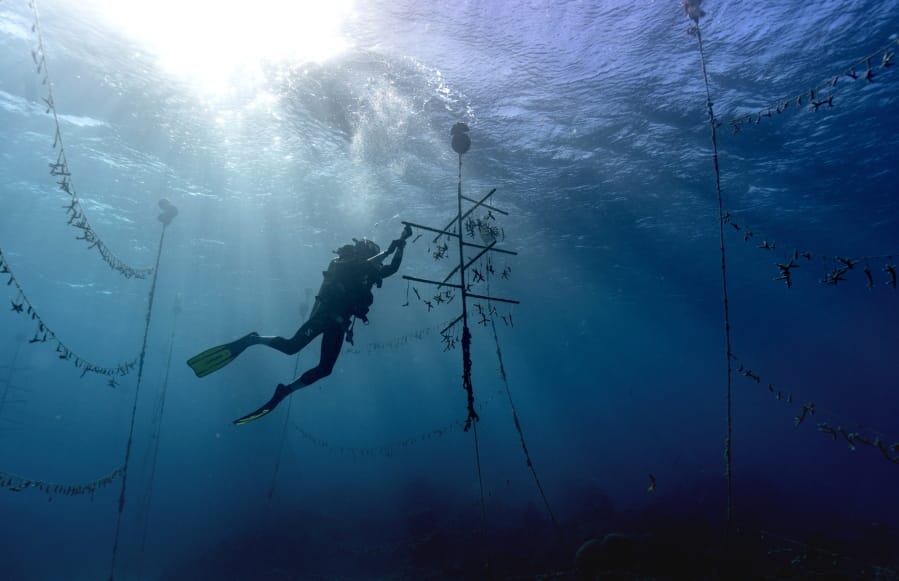OCHO RIOS, Jamaica — Everton Simpson squints at the Caribbean from his motorboat, scanning the dazzling bands of color for hints of what lies beneath. Emerald green indicates sandy bottoms. Sapphire blue lies above seagrass meadows. And deep indigo marks coral reefs. That’s where he’s headed.
He steers the boat to an unmarked spot that he knows as the “coral nursery.” ”It’s like a forest under the sea,” he says, strapping on blue flippers and fastening his oxygen tank before tipping backward into the azure waters. He swims down 25 feet carrying a pair of metal shears, fishing line and a plastic crate.
On the ocean floor, small coral fragments dangle from suspended ropes, like socks hung on a laundry line. Simpson and other divers tend to this underwater nursery as gardeners mind a flower bed — slowly and painstakingly plucking off snails and fireworms that feast on immature coral.
When each stub grows to about the size of a human hand, Simpson collects them in his crate to individually “transplant” onto a reef, a process akin to planting each blade of grass in a lawn separately.
A few hours later, at a site called Dickie’s Reef, Simpson dives again and uses bits of fishing line to tie clusters of staghorn coral onto rocky outcroppings — a temporary binding until the coral’s limestone skeleton grows and fixes itself onto the rock. The goal is to jumpstart the natural growth of a coral reef. And so far, it’s working.
Almost everyone in Jamaica depends on the sea, including Simpson, who lives in a modest house he built himself near the island’s northern coast. The energetic 68-year-old has reinvented himself several times, but always made a living from the ocean.
Once a spear fisherman and later a scuba-diving instructor, Simpson started working as a “coral gardener” two years ago — part of grassroots efforts to bring Jamaica’s coral reefs back from the brink.
Coral reefs are often called “rainforests of the sea” for the astonishing diversity of life they shelter.
Just 2 percent of the ocean floor is filled with coral, but the branching structures — shaped like everything from reindeer antlers to human brains — sustain a quarter of all marine species.
After a series of natural and man-made disasters in the 1980s and 1990s, Jamaica lost 85 percent of its once-bountiful coral reefs. Meanwhile, fish catches declined to a sixth of what they had been in the 1950s, pushing families that depend on seafood closer to poverty. Many scientists thought that most of Jamaica’s coral reef had been permanently replaced by seaweed, like jungle overtaking a ruined cathedral.
But today, the corals and tropical fish are slowly reappearing, thanks in part to a series of careful interventions.
The delicate labor of the coral gardener is only one part of restoring a reef — and for all its intricacy, it’s actually the most straightforward part. Convincing lifelong fishermen to curtail when and where they fish and controlling the surging waste dumped into the ocean are trickier endeavors.
Still, slowly, the comeback effort is gaining momentum.
“The coral are coming back; the fish are coming back,” says Stuart Sandin, a marine biologist at the Scripps Institution of Oceanography in La Jolla, Calif. “It’s probably some of the most vibrant coral reefs we’ve seen in Jamaica since the 1970s.”
“When you give nature a chance, she can repair herself,” he adds. “It’s not too late.”
At White River Fish Sanctuary, which is only about 2 years old and where Simpson works, the clearest proof of early success is the return of tropical fish that inhabit the reefs, as well as hungry pelicans, skimming the surface of the water to feed on them.
David Murray, head of the Oracabessa Fishers’ Association, notes that Jamaica’s 60,000 fishermen operate without a safety net. “Fishing is like gambling, it’s a game. Sometimes you catch something, sometimes you don’t,” he says.
When fish populations began to collapse two decades ago, something had to change.
Murray now works as a warden in the Oracabessa sanctuary, while continuing to fish outside its boundary. He also spends time explaining the concept to neighbors.
“It’s people work — it’s a process to get people to agree on a sanctuary boundary,” he says. “It’s a tough job to tell a man who’s been fishing all his life that he can’t fish here.”
But once it became clear that a no-fishing zone actually helped nearby fish populations rebound, it became easier to build support. The number of fish in the sanctuary has doubled between 2011 and 2017, and the individual fish have grown larger — nearly tripling in length on average — according to annual surveys by Jamaica’s National Environment and Planning Agency. And that boosts catches in surrounding areas.
After word got out about Oracabessa, other regions wanted advice.
Belinda Morrow runs the White River Marine Association. She attends fishers’ meetings and raises small grants from the Jamaican government and other foundations to support equipment purchases and coral replanting campaigns.
“We all depend on the ocean,” Morrow says, sitting in a small office decorated with nautical maps in the iconic 70-year-old Jamaica Inn. “If we don’t have a good healthy reef and a good healthy marine environment, we will lose too much. Too much of the country relies on the sea.”



